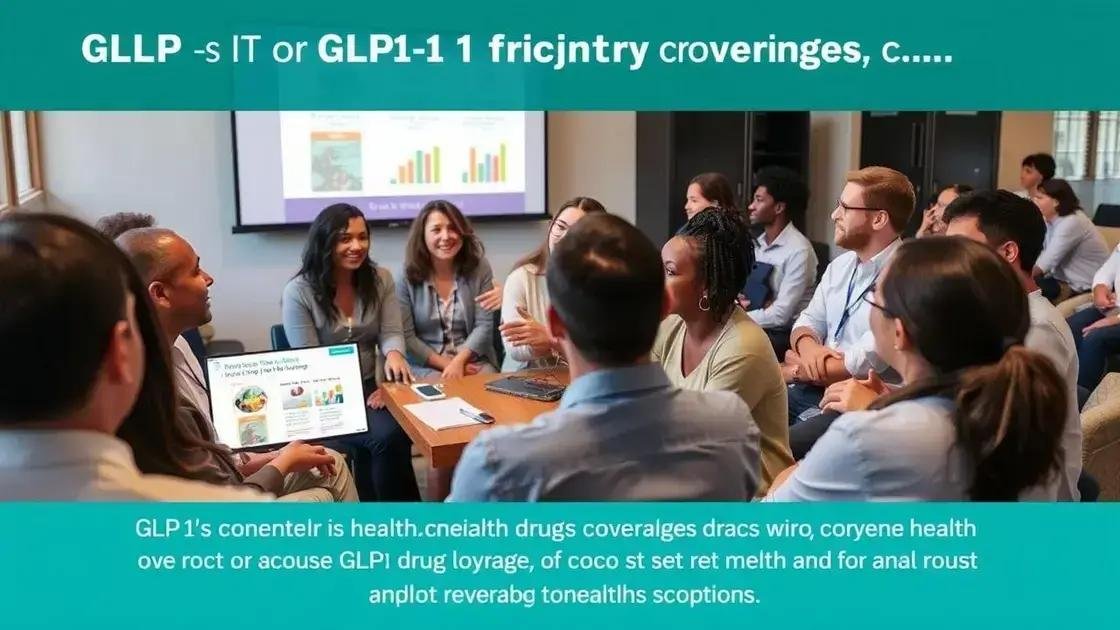GLP‑1 drug coverage in the workplace enhances employee health by improving diabetes management, increasing productivity, and reducing long-term healthcare costs, making it a valuable investment for employers.
GLP‑1 drug coverage workplace is becoming a vital topic as employers consider health benefits more closely. How does this coverage affect productivity and employee satisfaction? Let’s find out.
Understanding GLP‑1 drugs and their purpose
Understanding GLP‑1 drugs and their purpose is essential for both employers and employees. These medications are designed to manage blood sugar levels for individuals with type 2 diabetes. They work by mimicking the natural hormone GLP-1, which helps to regulate insulin secretion and reduces appetite.
How GLP‑1 Drugs Function
GLP‑1 drugs play a key role in controlling diabetes. By increasing insulin production when blood sugar levels are high, they help individuals maintain more stable glucose levels. Additionally, these drugs slow down gastric emptying, contributing to a feeling of fullness after meals.
Benefits of GLP‑1 Medications
These medications offer several benefits that may encourage their use in workplace health programs:
- Weight loss assistance improves overall health.
- Lower risk of cardiovascular events related to diabetes.
- Reduced need for insulin therapy, simplifying diabetes management.
Moreover, the introduction of GLP‑1 drugs has changed the landscape of diabetes treatment. Access to these medications can significantly improve employee health and productivity. Healthy employees are generally happier and more engaged at work, which leads to better performance and fewer sick days.
Education on how GLP‑1 drugs work can empower employees to discuss their options with healthcare providers. Understanding these drugs also allows for more informed decisions regarding treatment plans. Furthermore, with the rising prevalence of diabetes, offering coverage for these medications can be a valuable asset in attracting and retaining talent.
Potential Side Effects
While GLP‑1 drugs are beneficial, it is important to consider potential side effects. Some individuals may experience nausea, vomiting, or digestive issues. It’s essential for employees to communicate with their healthcare providers to weigh the benefits against any drawbacks.
Exploring workplace policies on GLP‑1 coverage
Exploring workplace policies on GLP‑1 coverage is vital for enhancing employee well-being and productivity. Many companies are now recognizing the importance of health benefits related to diabetes management. By offering coverage for these medications, employers can support their workforce effectively.
Why Coverage Matters
Workplace health benefits play a significant role in employee satisfaction. When employers provide access to GLP‑1 drugs, they demonstrate a commitment to their employees’ health. This not only enhances morale but can also lead to lower healthcare costs over time.
Key Considerations for Employers
Employers should evaluate their current health policies to see if they include coverage for GLP‑1 medications. Here are some important aspects to consider:
- Assess the overall cost implications of including GLP‑1 coverage.
- Investigate employee interest in diabetes management options.
- Collaborate with healthcare providers to determine the best solutions.
Additionally, educating employees about how to utilize their benefits can significantly improve engagement. This involves providing clear guidelines on how to access GLP‑1 drugs through company-sponsored health plans.
A supportive policy can lead to higher retention rates, as employees feel valued. Being proactive about managing conditions like diabetes through effective GLP‑1 coverage can ultimately strengthen company culture.
Best Practices in Implementation
Effective implementation of health policies for GLP‑1 coverage requires clear communication. Ensuring employees are aware of their benefits can enhance utilization. Consider holding workshops or sending newsletters that inform employees about diabetes and available medications.
Furthermore, regular assessments of policy effectiveness can help identify areas for improvement. This allows companies to adjust their benefits package as necessary to meet the evolving needs of their workforce.
The impact of GLP‑1 drug coverage on employee health

The impact of GLP‑1 drug coverage on employee health is significant and multifaceted. These medications can lead to better management of diabetes and overall health improvement for employees. Providing access to GLP‑1 drugs can result in tangible benefits for both workers and employers alike.
Health Benefits of GLP‑1 Coverage
When employees have access to GLP‑1 medications, they may experience improved blood sugar control. This can lead to reductions in diabetes-related complications, which ultimately enhance both quality of life and productivity. Healthier employees are often more engaged and take fewer sick days.
Financial Implications
For employers, the financial benefits of providing GLP‑1 coverage can be substantial. Fewer health-related absences translate to lower healthcare costs and increased productivity. Additionally, investing in employee health through medication coverage can improve retention rates, saving costs associated with employee turnover.
Moreover, studies suggest that when companies prioritize health benefits like GLP‑1 drug coverage, they cultivate a culture of wellness. This proactive approach encourages employees to take charge of their health, leading to healthier lifestyle choices and a supportive workplace environment.
Addressing Barriers to Access
It’s important for companies to consider potential barriers that employees may face when accessing GLP‑1 medications. High out-of-pocket costs can deter employees from filling prescriptions. Offering comprehensive coverage can help mitigate these challenges, ensuring that all employees have access to necessary medications.
By addressing these barriers and promoting GLP‑1 drug coverage, employers demonstrate their commitment to fostering a healthier workforce. This focus can enhance morale and loyalty among employees, contributing to a positive company culture.
Case studies: success stories from workplaces
Case studies from workplaces illustrate the positive impact of GLP‑1 drug coverage on employee health and productivity. Several companies have adopted policies that support access to these medications, leading to notable success stories that highlight the benefits.
Company A: Increased Productivity
One example is Company A, a tech firm that implemented GLP‑1 coverage in its health benefits package. After introducing this coverage, the company observed a significant increase in productivity among employees managing diabetes. With effective treatment, employees reported feeling more energetic and focused.
Company B: Improved Employee Retention
Another case study involves Company B, a manufacturing organization that experienced high turnover rates. By providing GLP‑1 medications as part of their health benefits, they saw a marked improvement in employee retention. Employees felt valued, and this resulted in a more stable workforce.
Company C: Enhanced Workplace Culture
In Company C, the introduction of GLP‑1 drug coverage fostered a culture of health and wellness. Employees participated in wellness programs and received education on diabetes management, contributing to increased morale and satisfaction. The company demonstrated the value of investing in employee health, which in turn led to better overall performance.
Lessons Learned
These case studies highlight the importance of GLP‑1 coverage in the workplace. They reveal that when employers prioritize health benefits, they can enhance productivity, retention, and workplace culture. The successes of these companies serve as powerful examples for other organizations looking to improve their health policies.
Future trends in GLP‑1 coverage at work
Future trends in GLP‑1 coverage at work are evolving, reflecting changes in healthcare needs and employee expectations. As more people are diagnosed with diabetes, companies are increasingly recognizing the importance of offering comprehensive health benefits, including GLP‑1 medications.
Emphasis on Preventative Care
One significant trend is a shift towards preventative care. Organizations are beginning to understand that by investing in GLP‑1 coverage, they can prevent serious health issues down the line. This not only helps employees but can also reduce long-term healthcare costs for employers.
Increased Flexibility in Health Plans
Employers are also moving towards more flexible health plans that allow employees to choose the coverage that best fits their needs. This includes options for GLP‑1 drug coverage, enabling employees to manage their diabetes more effectively. Personalization in health benefits is becoming a priority.
Integration of Technology in Health Management
Another trend is the integration of technology in health management. Apps and digital tools are now being used to help employees track their medications, including GLP‑1 drugs. These tools enhance engagement, making it easier for employees to manage their health.
Moreover, companies are starting to partner with health tech companies to provide tools that support employees in understanding their treatment options. This proactive approach fosters a culture of health and wellness in the workplace, leading to happier and healthier employees.
Focus on Education and Awareness
Education around diabetes management and the benefits of GLP‑1 coverage is becoming more common in workplaces. Employers are offering workshops, resources, and seminars that empower employees to make informed decisions about their health.
This focus on awareness not only supports those affected by diabetes but also creates a more inclusive workspace. As businesses continue to adapt to the changing healthcare landscape, these trends will likely shape the future of health benefits.
FAQ – Frequently Asked Questions about GLP‑1 Drug Coverage in the Workplace
What are GLP‑1 drugs and how do they work?
GLP‑1 drugs are medications that help manage blood sugar levels in people with type 2 diabetes by mimicking the effects of the hormone GLP-1, which regulates insulin secretion and appetite.
Why is GLP‑1 coverage important for employees?
GLP‑1 coverage is crucial as it supports employees in managing their diabetes effectively, leading to improved health, productivity, and overall job satisfaction.
How can employers implement GLP‑1 coverage?
Employers can implement GLP‑1 coverage by reviewing their health benefits packages, collaborating with healthcare providers, and ensuring clear communication with employees about available options.
What future trends should we expect regarding GLP‑1 drug coverage?
Future trends may include increased emphasis on preventative care, more flexible health plans, the integration of technology for medication management, and enhanced employee education around diabetes management.

